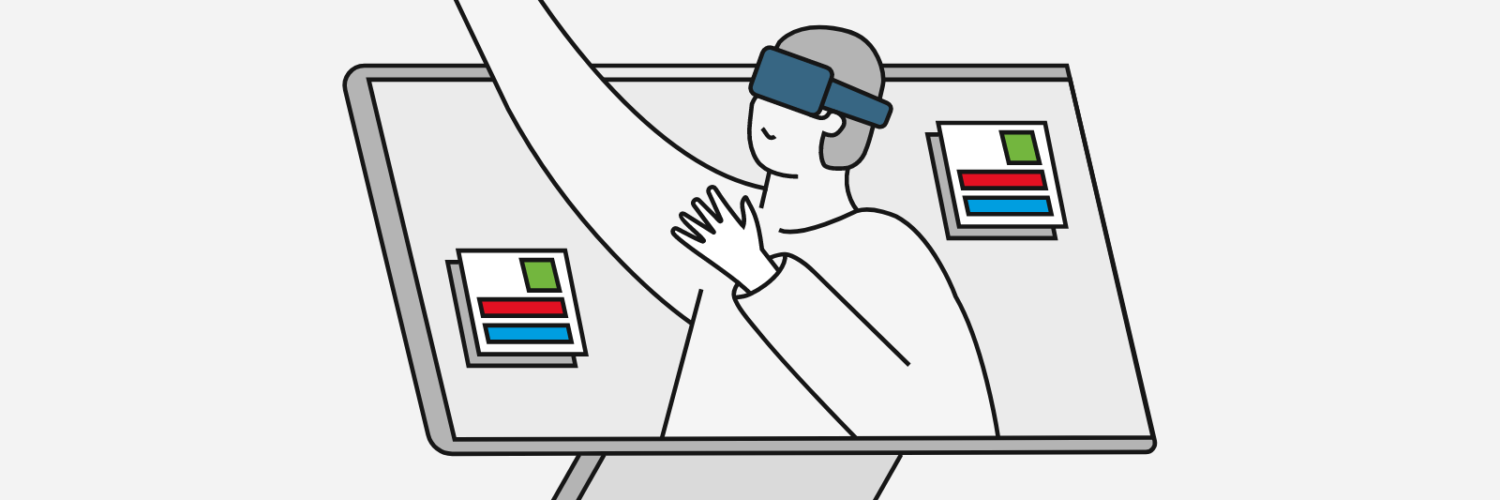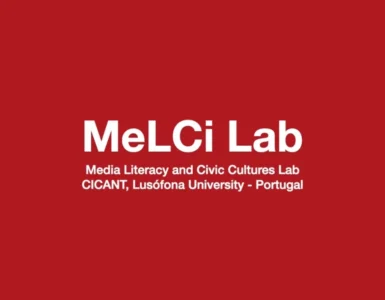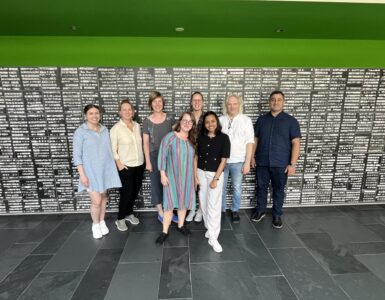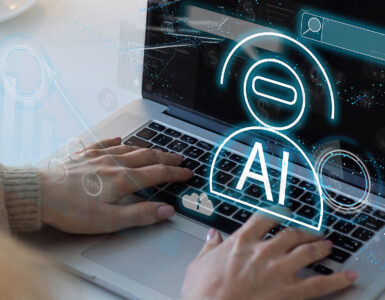by Zac Woolfitt, Inholland University, The Netherlands.
On Thursday 15th February, Media and Learning ran a virtual tour of three technology rich learning spaces at a university in the US, Belgium and the Netherlands. As moderator of the webinar, I saw first-hand the ways in which these three universities were pushing learning spaces to the next level. As a member of the advisory board of Media and Learning, I’ve had the opportunity to manage webinars on this subject in the past and was particularly interested to see the latest developments.
The three presentation recordings, slides, key takeaways, and highlights of the chat are here.
Technology Rich Learning Spaces are physical learning spaces which are enhanced by different levels of technology, where learning can be delivered synchronously or asynchronously. There are many different variables and understanding the different elements can sometimes be complex.
KU Leuven – Learning laboratory skills in a 360 immersive environment
Robbe Vanden Brande and Tula Verhalle of KU Leuven took us through the newest version of their ViSkiLab. Training students on basic safety in labs is complicated, time consuming and expensive. This VR solution addressed those issues.

With your VR glasses, you work your way through the 360 video laboratory, answering questions and interacting with lab staff and fellow students
I had seen the first iteration of this demonstrated in Leuven in 2022 when I spent 15 minutes in VR goggles working my way through a series of practical safety steps when working in a laboratory. Since then, they have trained more than 400 students a year on the basics of laboratory safety and lab protocol, before the students enter the lab for real.
They developed their own VR application and filmed with real students and staff in a real laboratory. Through a series of quiz questions, students can walk through basic safety instructions and answer multiple choice questions that pop up on the screen. This enables all students starting in a lab to have an ‘equal start level of competence’, being familiar with the lab environment, and knowing the correct procedures.
The software was in-house developed in Unity and integrated into a complex scenario. The VR session is based on a story line. This required investing time into the story, creating a murder mystery that had to be solved with different characters. Through answering a series of questions and working through various scenarios, the student finds out who is guilty. This engages and motivates students. The immersive experiences is more memorable. And along the way, they are learning key safety information.
Inside the virtual environment, the question pop-up, and there are ‘hotspots’ which can be clicked on that reveal additional information. At one point, a lab assistant in the VR space starts using their smartphone in the lab. The lab instructor tells them off and explains the reasons why they should not do this. The other lab assistants gathered around respond. This is a memorable moment and has much more impact than simply saying ‘don’t use your smartphone in the lab’.
Using the headsets is straightforward and is organised during lessons with an instructor, group of students and headsets. There are some practical logistics when running the course, of getting the headsets cleaned, charged, and delivered to the right classroom for the training. Students learn quickly how to navigate through the space.
Data has been collected on the effectiveness of the training. Those students who had the ViSkiLab training scored better on new knowledge than those who did not have the training. The environment has been used for several years, with some slight adjustments. However, in time, the scenarios, lab equipment, and hairstyles may become outdated, so new footage will have to be filmed.
According to Tula, they did multiple tests up front with students to optimize the VR app. They changed things such as how a student ‘enters’ the room, to avoid students feeling dizzy. The 360 video feed engages after a few seconds which gives students time to adjust to the environment. The original film was one hour. Now it is broken down into four pats so students can take a break after each part. However, many students choose to go straight through the whole session in one go.
It requires expert pedagogical, content, and technical knowledge for a university to develop and maintain this. The number of students trained annually is impressive. This is an excellent example of how a customised VR training course can use a creative approach to make the important subject of laboratory safety, both effective and fun.
This was a time-consuming project, so evaluate the added value of VR, and consider other less expensive options. There is an advantage in having ‘in-house’ knowledge and developing the software which gives greater control. The technology needs to be implementable and easy for every student to access.
University of Amsterdam – Highly Adaptable Hybrid Study Room
Linda van der Weg is team leader of the Library Learning Centre. She presented the flexible study room. The ceiling of the space has been adapted for acoustics, in order to minimise the noise in the space. There are two large screens, moveable furniture (on wheels), every table has a power socket, multiple white boards (small and large), many side screens and the use of the ‘meeting owl’ (see below). They have been experimenting in the new library space with different types of furniture and layouts which enable different scenarios.

A highly flexible learning spaces with furniture on wheels, screens, and lots of power sockets
One scenario involves arranging the furniture into group tables and providing hybrid lessons with teachers and students. They use a meeting Owl (an intelligent 360° conference camera, mic, and speaker that gets smarter over time) to pick up audio and video of the students in the classroom to communicate with those attending the session online.
Another scenario is when the room is not booked by teachers for a lesson; then students simply use the flexible learning spaces for their own study, moving the tables, screens and chairs into a space that works for the studying they are doing, individually or in groups. Additional ‘technology’ are several portable whiteboards which students use, and they sometimes go ‘missing’ because they are popular and practical learning devices, a good reminder that technology does not need to be complex.
And the two scenarios are sometimes combined, with a booked hybrid lesson taking place in one part of the space, while another part of the space is used for individual or group study by independent students who show up and use the remaining available space, moving screens around to block off and customise the learning space they need.
The room is one of the most popular study spaces for students. There is a lot of interaction and discussion and talking, so it is not a quiet space, and certainly not a usual ‘library environment’. It gets ‘turned upside down’ each day but is ‘reset’ to the original layout for the next day and it works very well. There are some challenges to inform teachers that the space is available and can be booked and reserved for lessons. Many teachers say they would like to innovate their education and want to develop more with active learning, and this room is suitable for this. It is considered a ‘smart use of square meters’ (and square meters are particularly expensive in Amsterdam!)
It is a highly adaptable lecture area, study room, or event space to be used by teachers and/or students. You should ensure that the room can be easily booked and reserved via the central timetable. Also, make sure there are always enough power sockets for phone, computer, and electrical bike batteries!
‘Greenscreen on steroids’ – University of Michigan XR studio
Jeremy Nelson is Senior Director of XR, Media Design & Production, Center for Academic Innovation, University of Michigan, USA. He is working on new projects and experiments that integrate XR into residential and online curricula to develop new XR related educational technology.

Composite image of University of Michigan XR studio. (clockwise from top left):
The control room, wet feet, the studio and cameras, the studio from above.
The University of Michigan has created more than 300 online courses, including via Coursera, EdEx and Michigan Online. Their state-of-the-art, custom built XR studio is set-up for just about any media production you could imagine. broadcast control room. The studio is built under a garage, so there were various steps taken to cover any ‘vibrations’ from the cars, and some serious air conditioning to keep the whole space workable.
It has a virtual production stage, complete lighting system with colour correction. They use ‘Disguise’ software, to render video content as it is produced in real time, a complete sound mixing board with 8 channels of audio, and various projectors. The screens in the studio are composed of 187 LED panels including on the floor which allows for the presenter to be ‘immersed’ in the virtual space (e.g., stepping in the sea as waves come in).
There are four cameras set up which have a tracking system that receives data from a number of sensors in the ceiling of the studio. This tells the system where each camera is in the 3d spaces. This allows for seamless tracking, and for the presenter to be correctly lit in real-time as they move around the studio. This enables the studio to
They have recorded many different courses, and have created scenarios inside a nuclear reactor, architecture projects where the presenter is moving in and out of 3d wooden constructions, and biology where the instructor moves ‘through’ DNA molecules while explaining the course content.
They have also made immersive courses, such as the ‘Black performance as social protest’ series, in which students and lecturers are merged into different historical scenes, moving through time, from the 1800’s to 2020 and black lives matter.

Jeremy demonstrates how you can move in and out of the 3d virtual space
The lecturer can be immersed into different environments (real footage, or AI generated backgrounds) and move within the scenes in an ‘unreal environment’. It requires quite some preparation to figure out the exact work-flow, and how to build an entire course. You need to carefully conder the didactical design issues to ensure it really works within the course that you make.
Not all faculty are comfortable teaching to the camera since ‘it can feel like you are up on stage’ so suitable training and support are important. The studio is not open for anyone to book, with a specific process to go through in order to book the studio time. It needs to be part of one of the courses that are funded. The faculty pitch the ideas based on clear learning goals and objectives. In addition, they need to specify in advance how the supporting pedagogy will be used to get the most out of the recorded content.
As Jeremy said, ‘we don’t really know what is possible.. this is green screen on steroids’. At the moment, they are producing between 30 and 50 online courses a year. A studio like this is a big investment, is highly complex, and there is a team of 110 involved in various aspects of the entire process. It is important to test and study the impact of the materials produced. The media will look pretty impressive, but the key is to ensure that the pedagogy integrates the media into the course to get the most out of the resources made. A studio like this is a large investment but there are simpler DIY green screen set-ups that can be used. All in all, a very impressive top-of-the-line studio which is being used in creative and original ways. I might just have to get myself over to Michigan for a test-drive!
Technology Rich Learning Spaces – a proposed framework
Many thanks to the presenters for sharing three interesting and different approaches to technology rich learning spaces. To compare the three scenarios presented in the webinar, I’ve listed and arranged various features of the technology rich learning spaces and their learning context. In this proposed framework, you can add categories of your learning space on a spectrum: from complex to simple, virtual to in-person, fixed to flexible. You can add additional categories and then map where you think your learning space lies on the spectrum.

Proposed framework for representing Technology Rich Learning Spaces in relation to each other.
The way I’ve mapped these three spaces places the University of Michigan to the left (more complex, online, higher budget), KU Leuven mainly in the middle (VR and in-person), and University of Amsterdam in the middle and on the right (hybrid classroom, delivered synchronously, interactive). But let me know if you see things differently. I’m open for input on how to represent the differences but this is my first quick version of comparing these three scenarios.
What I learned from the session is that there are many options out there, and choosing the right technology rich learning space for your organisation will be based on budget, space available and which learning goals you want to achieve. You need to have the innovative teachers to take the plunge and try-out these spaces. However, as always with educational media, it is the way in which it is integrated into the course from a pedagogical perspective that is the key to ensuring the learning effect is significant. To ensure that the media enhances and supports the learning process in these technology rich learning spaces.
Thank you for reading this far. Comments, suggestions, or corrections, please contact me directly at zac.woolfitt@inholland.nl.

Author
Zac Woolfitt, lecturer and researcher, Inholland University in the Netherlands














